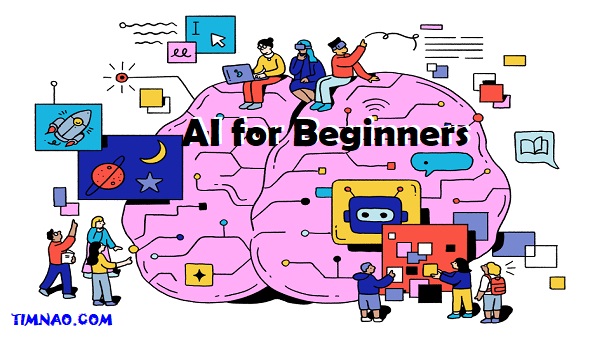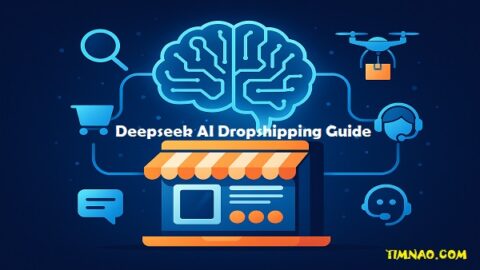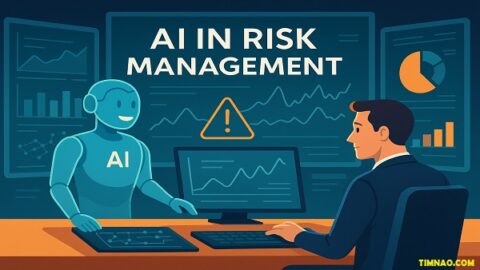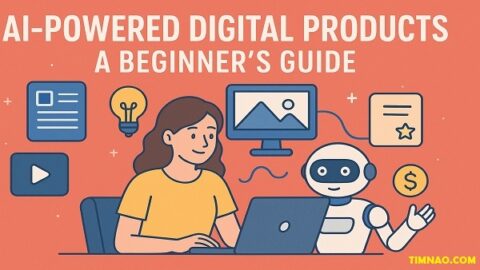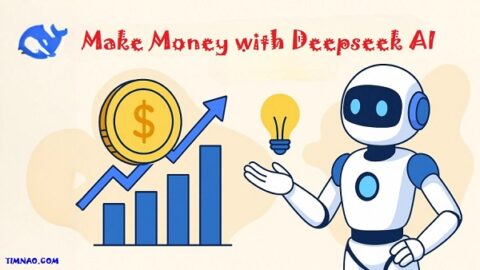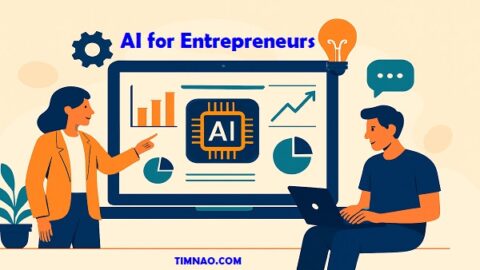Unlock Your Potential: The Ultimate Guide to AI for Beginners! 🤖
Artificial Intelligence (AI) is no longer a futuristic fantasy; it’s a powerful force reshaping our world, from the way we work and learn to how we manage our daily lives. If you’re new to the concept, the term “AI” might conjure images of complex robots or impenetrable code. But fear not! This comprehensive guide is designed specifically for AI for beginners, aiming to demystify the jargon, showcase practical AI applications, and empower you to learn Artificial Intelligence in an accessible and engaging way. Prepare to embark on an exciting journey into the realm of AI, where you’ll discover how this transformative technology can level up your career, automate tasks, and help you make smarter decisions – no technical background needed!
This article will guide you through the essentials of AI, enriched with the latest information and practical examples to ensure you’re up-to-date. We’ll explore how AI is already part of your everyday life, introduce you to user-friendly AI tools, and provide actionable advice to harness its potential. Let’s unlock the power of AI together!
📜 Table of Contents
- ✨ Decoding AI: Your First Steps into Artificial Intelligence
- What Exactly IS Artificial Intelligence (AI)?
- AI vs. Human Intelligence: Understanding the Core Differences
- Busting Common AI Myths: Separating Hype from Reality
- 🚀 The AI Revolution is Here: Current Trends You Need to Know
- Generative AI: Creating the Unimaginable
- Multimodal AI: Understanding the World Like Humans Do
- Agentic AI: The Dawn of Independent AI Systems
- The Rise of Responsible and Ethical AI
- 🏡 AI in Your Daily Life: Surprising Ways You’re Already Using It
- Your Smart Assistant: More Than Just a Voice
- Personalized Entertainment: How AI Knows Your Taste
- Smarter Shopping: AI’s Role in Your Online Experience
- Navigating Your World: AI in Maps and Transportation
- 🛠️ Your AI Toolkit: Beginner-Friendly Tools to Get Started
- ChatGPT and Other Conversational AI: Your Creative Partner
- AI for Content Creation: Tools like Canva AI, Jasper, and DALL-E 3
- Productivity Boosters: AI for Task Management and Automation
- AI for Learning: Language Apps and Educational Platforms
- 💼 Level Up Your Career with AI: Opportunities for Non-Technical Professionals
- Why Learning AI is a Smart Career Move
- AI in Various Industries: Practical Examples (Healthcare, Finance, Marketing)
- Developing In-Demand AI-Related Skills (Even Without Coding)
- Future-Proofing Your Career in an AI-Driven World
- 🤔 Navigating the Ethics of AI: A Beginner’s Perspective
- Understanding Algorithmic Bias and Fairness
- Data Privacy in the Age of AI
- The Importance of Human Oversight
- Joining the Conversation on AI Ethics
- 🔮 The Future is Intelligent: What’s Next for AI and You?
- AI for Good: Solving Global Challenges
- Lifelong Learning in the World of AI
- Embracing AI: Tips for Continuous Growth
- 💡 Actionable AI: Your Next Steps
- Simple Projects to Start Your AI Journey
- Finding Reliable Resources to Continue Learning
- Building Your AI Confidence
✨ Decoding AI: Your First Steps into Artificial Intelligence
Welcome to the fascinating world of Artificial Intelligence! If you’re an AI for beginner, this section is your starting point to learn Artificial Intelligence fundamentals in a simple, jargon-free way. We’ll break down what AI truly is, how it compares to human intelligence, and debunk some common misconceptions that might be holding you back.
What Exactly IS Artificial Intelligence (AI)?
At its heart, Artificial Intelligence refers to the ability of computers or machines to mimic human intelligence. This includes capabilities like learning from experience, recognizing patterns, solving problems, understanding language, and making decisions. Think of AI as creating smart software that can perform tasks that typically require human intellect.
AI systems are often built using complex sets of rules called algorithms and are trained on vast amounts of data. The more data an AI is exposed to, the better it generally becomes at its designated task. For example, an AI designed to identify cat pictures learns by analyzing thousands of images labeled as “cat” and “not cat.”
There are different types of AI. Some AI is designed for specific tasks (Narrow AI or Weak AI), like a chatbot answering customer queries or a recommendation engine suggesting movies. The AI we interact with daily largely falls into this category. The concept of Artificial General Intelligence (AGI or Strong AI), where a machine possesses intellectual capabilities comparable to a human across a wide range of tasks, is still largely theoretical and a subject of ongoing research.
AI vs. Human Intelligence: Understanding the Core Differences
While AI aims to simulate human intelligence, there are fundamental differences. Humans possess consciousness, emotions, intuition, and a deep understanding of context that current AI systems lack. AI excels at processing massive datasets, identifying patterns invisible to the human eye, and performing repetitive tasks with incredible speed and accuracy.
Humans learn through a combination of experience, instruction, and abstract reasoning. AI, particularly machine learning (a subset of AI), learns primarily from the data it’s fed. If the data is biased, the AI can inherit those biases. For example, if an AI is trained on historical hiring data that predominantly favored one gender for a particular role, it might perpetuate that bias in its future recommendations.
The key is to see AI not as a replacement for human intelligence, but as a powerful tool that can augment our capabilities. It can handle the data-intensive, repetitive aspects of tasks, freeing up humans to focus on creativity, critical thinking, strategic planning, and tasks requiring emotional intelligence.
Busting Common AI Myths: Separating Hype from Reality
As with any rapidly advancing technology, AI is surrounded by its fair share of myths and misunderstandings. Let’s tackle a few common ones:
- Myth 1: AI is going to take over the world and make humans obsolete.
- Reality: While AI is transforming jobs and industries, the idea of a malevolent AI superintelligence (like in sci-fi movies) is far from our current reality. Today’s AI is a tool designed and controlled by humans. The focus is on “Responsible AI” development, ensuring AI systems are safe, fair, and beneficial.
- Myth 2: You need to be a coding genius to understand or use AI.
- Reality: This is one of the biggest misconceptions, especially for AI for beginners. While developing advanced AI models requires technical expertise, using AI tools is becoming increasingly accessible. Many practical AI applications and platforms are designed with user-friendly interfaces that require no coding knowledge. Think of using a smartphone – you don’t need to know how its operating system is built to use its apps.
- Myth 3: AI is always objective and unbiased.
- Reality: AI systems learn from data. If that data reflects existing societal biases (related to race, gender, age, etc.), the AI can learn and even amplify these biases. Addressing and mitigating bias in AI is a significant area of research and ethical concern.
- Myth 4: AI is only for big tech companies and massive corporations.
- Reality: While large companies are major players in AI development, the technology is becoming more democratized. Cloud computing platforms offer access to powerful AI tools, and many open-source AI frameworks are available. Small businesses and individuals can leverage AI for various purposes, from marketing to personal productivity.
Understanding these basics is the first crucial step to confidently learn Artificial Intelligence and appreciate its vast potential without being intimidated by the hype.
🚀 The AI Revolution is Here: Current Trends You Need to Know
The field of Artificial Intelligence is evolving at an astonishing pace. Staying informed about the latest trends is key, even if you’re an AI for beginner. These advancements are not just theoretical; they are leading to exciting new practical AI applications that impact various aspects of our lives and work.
Generative AI: Creating the Unimaginable
You’ve likely heard a lot about Generative AI, and for good reason. This is one of the most explosive AI trends. Generative AI models, like OpenAI’s ChatGPT and DALL-E 3, or Google’s Gemini, can create new and original content – text, images, audio, video, and even code – based on the data they were trained on. For example, you can ask ChatGPT to write a poem, generate a blog post outline (much like this one!), or explain a complex topic in simple terms. Tools like Midjourney and DALL-E 3 can create stunning, unique images from text descriptions.
The implications are vast, impacting creative industries, content marketing, software development, and much more. Businesses are increasingly using Generative AI for content creation, customer support automation, and even to generate trillions of dollars in value across industries.
Multimodal AI: Understanding the World Like Humans Do
Traditionally, AI models specialized in one type of data – either text, images, or audio. Multimodal AI is a game-changer because it can process and understand information from multiple types of data simultaneously, much like humans do. Imagine an AI that can “see” an image, “hear” a question about it, and “speak” an answer, or generate an image based on a spoken description.
OpenAI’s GPT-4o is a prime example, capable of processing text, audio, and images. This allows for more natural and intuitive interactions. Multimodal AI is enhancing tasks like image and emotional recognition, visual question answering, and text-to-image generation, with significant applications in healthcare (analyzing medical images alongside patient history), robotics, and creating more accessible user interfaces.
Agentic AI: The Dawn of Independent AI Systems
The next frontier in AI is “Agentic AI” or “AI Agents.” We’re moving from AI that simply follows instructions to AI that can understand its environment, set its own goals, make decisions, and take actions independently to achieve those objectives without constant human intervention.
Think of an AI that doesn’t just book a flight when you ask, but plans an entire trip for you based on your preferences and budget, including making reservations and coordinating logistics. In business, AI agents could manage customer service inquiries from start to finish, or in environmental monitoring, they could gather data, identify patterns like early signs of a forest fire, and initiate preventative actions. Tools from companies like Salesforce are already incorporating agentic AI capabilities. These AI agents are expected to become the ultimate personal assistants for both individuals and businesses in the coming years.
The Rise of Responsible and Ethical AI
As AI becomes more powerful and integrated into our lives, the importance of developing and deploying it responsibly and ethically is paramount. There’s a growing global awareness and movement towards “Responsible AI.” This involves ensuring that AI systems are:
- Fair and Unbiased: Actively working to identify and mitigate biases in data and algorithms.
- Transparent and Explainable: Making it clear how AI systems make decisions (Explainable AI or XAI).
- Secure and Safe: Protecting AI systems from malicious attacks and ensuring they operate safely.
- Accountable: Establishing clear lines of responsibility for AI-driven outcomes.
- Privacy-Preserving: Ensuring that personal data is handled ethically and securely.
- Human-Centric: Designed to augment human capabilities and uphold human values. Major tech companies and international organizations like UNESCO are developing ethical guidelines and frameworks. AI legislation and regulation are also evolving globally, with initiatives like the EU AI Act aiming to create a legal framework for trustworthy AI. This focus on ethics is crucial for building public trust and ensuring that AI benefits humanity as a whole.
Other significant trends include AI in Healthcare for diagnostics and personalized medicine, Quantum AI (though still in its infancy), AI in Cybersecurity, and Sustainable AI (addressing the energy consumption of AI systems and using AI for environmental solutions). Understanding these trends will help you appreciate the dynamic nature of AI and its ever-expanding potential.
🏡 AI in Your Daily Life: Surprising Ways You’re Already Using It
Many AI for beginners are surprised to learn that they interact with Artificial Intelligence multiple times a day, often without even realizing it. AI isn’t just confined to research labs; it’s woven into the fabric of our digital experiences, making many tasks smoother and more personalized. Let’s explore some common practical AI applications you encounter regularly.
Your Smart Assistant: More Than Just a Voice
Virtual assistants like Apple’s Siri, Amazon Alexa, and Google Assistant are prime examples of AI in action. When you ask Siri for the weather, tell Alexa to play your favorite song, or instruct Google Assistant to set a reminder, you’re using Natural Language Processing (NLP), a branch of AI. These assistants:
- Understand your spoken commands: NLP helps them interpret what you’re saying.
- Learn your preferences: Over time, they adapt to your voice, accent, and common requests.
- Manage daily tasks: They can send messages, make calls, schedule appointments, and control smart home devices (like lights and thermostats).
- Provide information: They search the web to answer your questions in real-time. These AI-powered tools offer hands-free assistance, making everyday tasks more convenient.
Personalized Entertainment: How AI Knows Your Taste
Ever wondered how Netflix seems to know exactly what movie you’ll want to watch next, or how Spotify curates playlists that perfectly match your mood? That’s AI-powered recommendation algorithms at work. These systems:
- Analyze your viewing/listening habits: They track what you watch, listen to, like, dislike, and how long you engage with content.
- Identify patterns: They compare your behavior with millions of other users to find similarities.
- Predict your preferences: Based on these patterns, they suggest new movies, shows, songs, or artists you might enjoy. This use of AI makes content discovery more efficient and personalized, ensuring you spend less time searching and more time enjoying.
Smarter Shopping: AI’s Role in Your Online Experience
AI is a driving force in e-commerce, enhancing your shopping experience in several ways:
- Personalized recommendations: Just like with entertainment, online retailers like Amazon use AI to suggest products based on your Browse history, past purchases, and items other similar shoppers have bought.
- Chatbots for customer service: Many e-commerce sites use AI chatbots to answer frequently asked questions, track orders, and handle basic customer support issues 24/7.
- Dynamic pricing: AI algorithms can adjust prices in real-time based on demand, competitor pricing, and inventory levels.
- Fraud detection: AI helps identify and prevent fraudulent transactions, making online shopping safer.
- Virtual try-ons: Some platforms use Augmented Reality (AR) powered by AI to let you virtually try on clothes or see how furniture would look in your home.
Navigating Your World: AI in Maps and Transportation
Getting from point A to point B has become significantly easier thanks to AI:
- GPS and Route Optimization: Apps like Google Maps and Waze use AI to calculate the fastest routes, predict traffic conditions in real-time, and suggest alternatives to avoid delays caused by accidents or construction. They learn from data contributed by millions of users.
- Ride-sharing services: Companies like Uber and Lyft use AI for dynamic pricing, matching drivers with riders efficiently, and optimizing routes.
- Autonomous Vehicles (Self-Driving Cars): While still evolving, self-driving cars from companies like Tesla and Waymo (a subsidiary of Alphabet, Google’s parent company) rely heavily on AI, computer vision, sensors (like LIDAR), and machine learning to perceive their surroundings, make driving decisions, and navigate safely.
These are just a few examples of how AI is already an integral part of our daily routines. From spam filters in your email that learn to block unwanted messages to the AI that helps with language translation on the go, the practical AI applications are widespread and constantly growing, making our lives more convenient and efficient.
🛠️ Your AI Toolkit: Beginner-Friendly Tools to Get Started
Now that you have a better understanding of what AI is and how it’s already around us, you might be eager to learn Artificial Intelligence by trying out some tools yourself. The good news is that many powerful and practical AI applications are designed with AI for beginners in mind, requiring little to no technical expertise. Here’s a look at some categories of AI tools you can explore:
ChatGPT and Other Conversational AI: Your Creative Partner
Conversational AI tools, led by the incredibly popular ChatGPT from OpenAI, have revolutionized how we interact with AI. These tools, often based on Large Language Models (LLMs), can understand and generate human-like text. You can use them for:
- Brainstorming ideas: For projects, articles, business names, etc.
- Writing assistance: Drafting emails, reports, social media posts, or even creative stories.
- Summarizing long texts: Getting the gist of articles or documents quickly.
- Learning and explanation: Asking for complex topics to be explained in simple terms.
- Coding help: Generating code snippets or debugging existing code.
- Translation: Translating text between languages. Other notable conversational AI tools include Claude by Anthropic and Google’s Gemini. Many of these offer free tiers, making them highly accessible.
AI for Content Creation: Tools like Canva AI, Jasper, and DALL-E 3
Beyond text, Generative AI tools are empowering everyone to become a creator:
- AI Image Generators:
- DALL-E 3 (OpenAI): Creates highly detailed and creative images from text prompts. Often integrated with ChatGPT Plus.
- Midjourney: Known for producing artistic and high-quality images, accessible via Discord.
- Canva AI Art Generator: Integrated into the popular Canva design platform, allowing you to easily add AI-generated images to your designs.
- AI Writing Assistants:
- AI Music & Video Generators:
- AIVA: Specializes in generating music in various styles.
- Runway ML: Offers tools for AI video editing, generation, and effects.
- ElevenLabs: Provides advanced text-to-speech and AI voice generation. These tools can help you create unique visuals, engaging copy, and even music or video clips with simple text prompts or intuitive interfaces.
Productivity Boosters: AI for Task Management and Automation
AI can significantly enhance your productivity by automating repetitive tasks and helping you stay organized:
- AI-Enhanced Task Management: Tools like Trello with its Butler automation or Notion AI can help organize tasks, set reminders, and automate workflows within your project management boards.
- Workflow Automation: Platforms like Zapier or Microsoft Power Automate allow you to connect different apps and services to automate repetitive processes (e.g., saving email attachments to cloud storage, posting social media updates from blog posts).
- Email Management: AI tools can help sort your inbox, draft replies, and summarize email threads.
- Meeting Assistants: Tools like Otter.ai and Fireflies.ai can transcribe meetings, generate summaries, and identify action items.
AI for Learning: Language Apps and Educational Platforms
AI is also transforming how we learn new skills:
- Language Learning Apps: Platforms like Duolingo and Babbel use AI to personalize lessons, provide instant feedback on pronunciation, and adapt to your learning pace.
- AI Tutors and Educational Assistants: Tools like Khanmigo (from Khan Academy) use AI to provide personalized tutoring and learning support for students.
- Research and Information Gathering: AI tools can help you quickly find and synthesize information from vast online resources.
The key to getting started is to pick one or two tools that seem relevant to your interests or needs and begin experimenting. Many offer free trials or versions, allowing you to explore their capabilities without commitment. Remember, the goal is to find practical AI applications that make your life easier or more creative.
💼 Level Up Your Career with AI: Opportunities for Non-Technical Professionals
The rise of Artificial Intelligence isn’t just for tech wizards; it’s creating new opportunities and reshaping roles across all industries. For individuals, including AI for beginners and those in non-technical fields, to learn Artificial Intelligence concepts and how to work alongside AI tools is rapidly becoming a crucial skill for career development and future-proofing.
Why Learning AI is a Smart Career Move
Understanding and utilizing AI can give you a significant competitive advantage in the job market. Here’s why:
- Increased Efficiency and Productivity: AI can automate repetitive tasks, freeing you up to focus on more strategic, creative, and high-value work. This makes you a more valuable employee.
- Improved Decision-Making: AI tools can analyze vast amounts of data to provide insights that lead to better, more informed decisions in your role.
- Enhanced Problem-Solving: AI can help identify patterns and solutions that might not be obvious to humans, aiding in tackling complex challenges.
- New Job Opportunities: Entirely new roles are emerging that require AI literacy, such as AI ethics consultants, AI product managers, and professionals who can manage and interpret AI-driven analytics in specific domains (like marketing or finance).
- Staying Relevant: As AI becomes more integrated into workplaces, familiarity with AI tools and concepts will transition from a desirable skill to a necessary one. Recent statistics show a steady growth in AI adoption by businesses, with many executives believing AI provides a competitive advantage.
AI in Various Industries: Practical Examples (Healthcare, Finance, Marketing)
AI’s impact is being felt across diverse sectors:
- Healthcare: AI is used for analyzing medical images (like X-rays and MRIs) for faster and more accurate diagnoses, predicting patient risks, personalizing treatment plans, and powering virtual health assistants. Even without being a data scientist, healthcare professionals who understand AI’s capabilities can better leverage these tools for improved patient care.
- Finance and Banking: AI is crucial for fraud detection, algorithmic trading, risk assessment, personalized financial advice, and automating customer service through chatbots. Financial analysts and planners who can work with AI-driven insights are in high demand.
- Marketing and Advertising: AI helps automate content creation (using tools like Jasper), analyze consumer behavior, segment audiences, personalize advertising campaigns, and optimize ad spending. Marketing professionals skilled in using AI analytics tools can create more effective and targeted campaigns.
- Retail and E-commerce: AI powers recommendation engines, manages inventory predictively, personalizes customer experiences, and optimizes supply chains.
- Manufacturing: AI is used for predictive maintenance of machinery, quality control through computer vision, and optimizing production processes. Even in fields like education, human resources, and legal services, practical AI applications are streamlining workflows and creating new efficiencies.
Developing In-Demand AI-Related Skills (Even Without Coding)
You don’t need to become a programmer to benefit from AI in your career. Here are some valuable skills for non-technical professionals:
- Data Literacy: The ability to understand, interpret, and communicate data-driven insights is crucial. This means knowing how to read reports generated by AI tools and ask the right questions about the data.
- Prompt Engineering: Learning how to effectively communicate with Generative AI tools (like ChatGPT) to get the desired output is a valuable new skill.
- Familiarity with AI Tools: Gaining hands-on experience with relevant AI software in your field (e.g., AI-powered CRM for sales, AI analytics for marketing, AI writing assistants for content roles).
- Critical Thinking and Problem Solving: AI is a tool; humans are still needed to define problems, interpret AI outputs critically, and apply solutions creatively.
- Ethical Awareness: Understanding the ethical implications of AI in your industry (bias, privacy, etc.) is becoming increasingly important.
- Adaptability and Lifelong Learning: The AI field is constantly changing, so a willingness to learn new tools and concepts is key.
Future-Proofing Your Career in an AI-Driven World
To thrive in the evolving job market:
- Start with the Basics: Understand fundamental AI concepts.
- Identify AI’s Impact on Your Field: Research how AI is being used in your industry and specific role.
- Learn Relevant AI Tools: Many platforms like Coursera, Udacity, and even LinkedIn Learning offer courses and certifications in AI for various professional fields, including “AI for Business Leaders” or specialized AI applications in marketing or finance.
- Build a Portfolio of AI-Assisted Work: Showcase projects where you’ve used AI to achieve results.
- Network with AI-Savvy Professionals: Join online communities and attend webinars to stay updated.
Embracing AI doesn’t mean your job is at risk; it means you have an opportunity to enhance your skills, become more effective, and position yourself for future success.
🤔 Navigating the Ethics of AI: A Beginner’s Perspective
As Artificial Intelligence becomes more powerful and integrated into our daily lives and critical systems, it’s essential for everyone, including AI for beginners, to understand the ethical considerations that come with it. Thinking about ethics helps ensure that as we learn Artificial Intelligence and use its practical AI applications, we do so responsibly and for the benefit of all.
Understanding Algorithmic Bias and Fairness
One of the most significant ethical challenges in AI is algorithmic bias. AI systems learn from the data they are trained on. If this data reflects historical or societal biases related to race, gender, age, socioeconomic status, or other characteristics, the AI can inadvertently learn and even amplify these biases.
For example:
- An AI used for screening job applications might unfairly favor candidates from certain demographic groups if its training data predominantly featured successful applicants from those groups in the past.
- Facial recognition systems have historically shown lower accuracy rates for individuals with darker skin tones or for women, due to underrepresentation in training datasets. Ensuring fairness in AI means actively working to identify and mitigate these biases by using diverse and representative datasets, designing fairer algorithms, and continuously auditing AI systems for biased outcomes.
Data Privacy in the Age of AI
AI systems often require vast amounts of data to function effectively, much of which can be personal and sensitive. This raises significant privacy concerns:
- Data Collection: How is data being collected? Are individuals aware of it and have they given informed consent?
- Data Usage: How is the collected data being used by AI systems? Is it being used for purposes beyond what was initially stated?
- Data Security: How is personal data being protected from breaches, unauthorized access, or misuse?
- Surveillance: AI technologies like facial recognition and voice analysis can be used for mass surveillance, potentially infringing on individual liberties. Regulations like the General Data Protection Regulation (GDPR) in Europe aim to protect personal data, but vigilance from both developers and users is crucial. As a user, be mindful of the data you share and the privacy settings of the AI tools you use.
The Importance of Human Oversight
While AI can automate many tasks and make complex decisions, it’s crucial to maintain meaningful human control and oversight, especially in critical applications. AI systems, no matter how advanced, lack human judgment, empathy, and the ability to understand nuanced contexts or unforeseen consequences.
Human oversight is necessary to:
- Review and validate AI decisions: Especially in areas like medical diagnosis, loan applications, or criminal justice.
- Intervene when AI makes errors: Or when it produces harmful or unfair outcomes.
- Ensure accountability: Humans must ultimately be responsible for the deployment and impact of AI systems. The goal is not for AI to replace human decision-makers entirely, but to augment their capabilities, acting as a powerful assistant that requires human guidance and ethical stewardship.
Joining the Conversation on AI Ethics
AI ethics is not just a topic for experts; it’s a societal conversation that requires diverse perspectives. As an individual, you can contribute by:
- Staying Informed: Learn about the ethical challenges and discussions happening around AI. Resources from organizations like UNESCO and research institutions often provide accessible information.
- Advocating for Responsible AI: Support initiatives and policies that promote ethical AI development and deployment.
- Being a Critical User: Question the AI tools you use. Understand their potential biases and privacy implications.
- Providing Feedback: If you encounter an AI system that seems unfair or problematic, provide feedback to the developers or relevant authorities. Engaging with AI ethics ensures that the technology develops in a way that aligns with human values and contributes positively to society.
🔮 The Future is Intelligent: What’s Next for AI and You?
As we’ve journeyed through the fundamentals of Artificial Intelligence, explored its current applications, and considered its ethical dimensions, it’s clear that AI is set to play an even more significant role in our future. For AI for beginners and seasoned users alike, understanding the trajectory of AI and how to adapt is crucial for personal and professional growth.
AI for Good: Solving Global Challenges
Beyond individual convenience and business efficiency, AI holds immense potential to address some of the world’s most pressing challenges. This “AI for Good” movement focuses on leveraging AI to:
- Advance Healthcare: From accelerating drug discovery and personalizing cancer treatments to improving diagnostic accuracy in underserved regions.
- Combat Climate Change: Optimizing energy consumption, developing sustainable materials, improving climate modeling and prediction, and monitoring deforestation.
- Enhance Education: Providing personalized learning experiences for students globally, bridging educational gaps, and creating adaptive learning tools.
- Improve Agriculture: Optimizing crop yields, reducing water usage, and detecting plant diseases early to enhance food security.
- Aid in Disaster Response: Analyzing satellite imagery to assess damage, optimizing logistics for aid delivery, and predicting natural disasters with greater accuracy. The ability of AI to analyze complex data and identify patterns offers new avenues for innovation and problem-solving on a global scale.
Lifelong Learning in the World of AI
The field of AI is characterized by rapid and continuous evolution. New models, tools, and applications emerge frequently. Therefore, a mindset of lifelong learning is essential to keep pace and continue to learn Artificial Intelligence effectively.
- Stay Curious: Follow AI news from reputable sources. Explore new tools and case studies.
- Embrace New Skills: As AI automates certain tasks, focus on developing uniquely human skills like critical thinking, creativity, emotional intelligence, and complex problem-solving, which are complemented by AI rather than replaced.
- Upskill and Reskill: Be open to learning new technical skills if they align with your career goals, or focus on understanding how to manage and work alongside AI systems in your specific domain. Online courses, workshops, and certifications can be valuable here.
- Adaptability: The ability to adapt to new technologies and changing job roles will be a key determinant of success in an AI-driven future.
Embracing AI: Tips for Continuous Growth
For those who have started their journey as AI for beginners, here are some tips to continue growing your understanding and application of AI:
- Experiment Regularly: Don’t be afraid to try out new AI tools and features. Hands-on experience is one of the best ways to learn.
- Join AI Communities: Participate in online forums (like Reddit’s r/MachineLearning), discussion groups, or local meetups. Learning from others and sharing your experiences can be incredibly valuable.
- Focus on Practical Applications: Think about how AI can solve real-world problems in your personal life or work. This makes learning more relevant and engaging.
- Understand the “Why” Not Just the “How”: Try to understand the underlying concepts of AI, not just how to use a specific tool. This will help you adapt as tools change.
- Be an Ethical User and Advocate: Always consider the ethical implications of the AI you use or develop. Promote responsible AI practices.
The future with AI is not about being passively shaped by technology, but actively engaging with it, guiding its development, and harnessing its power to create a better, more intelligent, and equitable world. Your journey to learn Artificial Intelligence is an ongoing adventure filled with discovery and opportunity.
💡 Actionable AI: Your Next Steps
You’ve absorbed a wealth of information on AI for beginners, from understanding core concepts and current trends to exploring practical AI applications and ethical considerations. Now, it’s time to turn that knowledge into action! Here are some tangible steps you can take to continue your journey and learn Artificial Intelligence in a hands-on way.
Simple Projects to Start Your AI Journey
The best way to solidify your understanding is by doing. Here are a few simple project ideas that don’t require coding:
- Master a Generative AI Tool for Daily Tasks:
- Tool: Use ChatGPT or a similar conversational AI.
- Project: For one week, use it to help you with various tasks:
- Draft three different types of emails (e.g., a professional inquiry, a thank-you note, a casual catch-up).
- Brainstorm five content ideas for a blog or social media.
- Summarize a news article you find interesting.
- Ask it to explain a concept you’re curious about in simple terms.
- Generate a healthy meal plan for three days.
- Goal: Get comfortable with prompt engineering and discover the tool’s versatility.
- Create AI-Generated Art:
- Tool: Use a free tier of an AI image generator like Canva’s AI Art Generator, or explore prompts with DALL-E 3 if you have access.
- Project: Try to generate images for specific themes: “a futuristic cityscape at sunset,” “a whimsical forest creature,” or “an abstract representation of ‘calm’.” Experiment with different descriptive words and styles.
- Goal: Understand how text prompts translate into visual outputs and explore your creativity.
- Automate a Small, Repetitive Task:
- Tool: Explore a free automation tool like IFTTT (If This Then That).
- Project: Set up a simple applet, for example:
- “If I post a new photo on Instagram, save it to my Dropbox.”
- “If the weather forecast predicts rain tomorrow, send me a notification.”
- Goal: Experience the power of simple automation and how AI can connect different services.
- Explore AI in a Hobby or Interest:
- Tool: Find an AI tool relevant to your hobby (e.g., AI music generators if you like music, AI fitness planners if you’re into exercise, AI recommendation engines on platforms like Goodreads if you love reading).
- Project: Dedicate some time to using the tool to enhance your hobby. For example, try to compose a short melody or get personalized book recommendations based on your ratings.
- Goal: See how AI can be applied to areas you’re already passionate about.
Finding Reliable Resources to Continue Learning
The internet is full of information about AI, but it’s important to find credible sources:
- Reputable Online Course Platforms:
- Coursera, edX, Udacity: Offer courses from universities and industry experts, often with beginner-friendly options like “AI for Everyone.”
- DeepLearning.AI: Founded by Andrew Ng, provides more specialized AI courses.
- Educational Websites & Initiatives:
- Elements of AI: A free online course by Reaktor and the University of Helsinki, designed to demystify AI.
- Google AI Education: Offers various resources and tutorials.
- IBM SkillsBuild: Provides free courses on AI and data science.
- Tech News and Publications: Follow reputable tech news sites that cover AI developments (e.g., WIRED, MIT Technology Review, TechCrunch).
- Books: Look for introductory books on AI written for a general audience.
- AI Communities: Engage in online forums like Reddit’s r/artificialintelligence or specific AI tool communities on platforms like Discord.
Building Your AI Confidence
Learning anything new can be daunting, but here’s how to build confidence:
- Start Small and Be Patient: Don’t try to learn everything at once. Focus on one concept or tool at a time.
- Celebrate Small Wins: Every new skill learned or successful project completed is progress.
- Don’t Fear Mistakes: Mistakes are part of the learning process. Experiment and see what happens.
- Ask Questions: Utilize online communities or forums if you get stuck.
- Share Your Knowledge: Explaining what you’ve learned to someone else is a great way to solidify your own understanding.
Your AI journey is just beginning. By taking these actionable steps, you’ll not only learn Artificial Intelligence more deeply but also discover the many ways these practical AI applications can enrich your life and career. Embrace the learning process, stay curious, and enjoy the incredible potential that AI unfolds!
Reference video:

